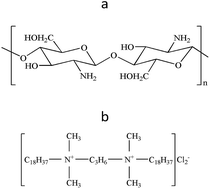Chitosan/organic rectorite nanocomposites rapidly synthesized by microwave irradiation: effects of chitosan molecular weight
Abstract
Chitosans with high and low molecular weight (CSH and CSL) were intercalated into organic rectorite (OREC) to prepare chitosan/organic rectorite nanocomposites (CSHOR and CSLOR) via a microwave irradiation method for 75 min, which was found to be much more efficient than the conventional 48 h heating method. The structure and intercalation mechanism of the nanocomposites were investigated by XRD, FT-IR, and zeta potential analysis, and the effects of chitosan (CS) molecular weight on the morphology, crystallization behavior, thermal stability, and antibacterial properties of the nanocomposites were explored. The results indicated that: (1) CSH and CSL were inserted successfully into the silicate layers to form the intercalated nanocomposites, and interlayer spacing could be increased to 5.14 nm and 6.40 nm, respectively. (2) CS and OREC were joined together through hydrogen bonding and electrostatic interaction. (3) Compared to CSH and CSL, the thermal stability and antibacterial properties of both CSHOR and CSLOR were significantly improved. (4) With decreasing CS molecular weight the interlayer distance of OREC increased, which resulted in morphological and crystallization changes to the nanocomposites and enhanced antibacterial activity without impacting thermal stability.


 Please wait while we load your content...
Please wait while we load your content...